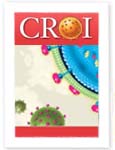Welcome
Dear Reader,

As I take over the role of Director of SHM, I notice that I have some pretty large shoes to fill. Frank de Wolf resigned in December last year to start a new position as General Manager and Medical Director at the Crucell Vaccine Institute after founding and working at SHM for over 11 years. Since SHM was founded in 2001, the organisation has grown to over 40 employees with perhaps one of the best HIV data collection sets of any country. Frank’s input into the development and achievements of SHM, supported by a strong team of professionals, are undeniable and I would like to thank him for handing over such an established and smooth-running organisation.
This eNewsletter includes an interview with me wherein I discuss my background and vision for SHM. There are also some articles from other members of the SHM team: Luuk Gras discusses his work, particularly focusing on trends in HIV virulence, Colette Smit writes about HIV and pregancy, and there is an interview with new SHM data monitor, Anna de Lang. There is also a round-up of science presented by SHM at the recent CROI conference in Atlanta (USA).
I hope that you will enjoy reading this edition of the newsletter. Any feedback you may have is welcome.
Kind regards,
Peter Reiss
Director, Stichting HIV Monitoring

An interview with SHM's new director - Peter Reiss
Peter Reiss joined SHM on 1 February 2013, replacing Frank de Wolf as the director of the foundation. Peter is also a Professor of Internal Medicine at the Academic Medical Centre at the University of Amsterdam (AMC-UvA). In addition, he serves on the Scientific Advisory Boards of the Agence Nationale de Recherches sur le Sida et les hépatites (ANRS) and the Swiss HIV Cohort Study, as well as on the Steering Committees of the D:A:D study, the ART-Cohort Collaboration, and the EuroSIDA Study. He also is one of the rotating scientific coordinators of the EU-funded EuroCoord collaboration. In this interview he talks about his work at the AMC, his background with SHM and his vision for the future. Read more

Studying trends in HIV virulence
 Luuk Gras is a statistician at the Stichting HIV Monitoring (SHM). His work involves supporting other researchers with their analyses, and doing his own research. This includes monitoring of markers of disease progression and comparing statistical methods in the analysis of HIV observational data. One of his interests is trends in HIV virulence, which the following article discusses in further detail. Read more Luuk Gras is a statistician at the Stichting HIV Monitoring (SHM). His work involves supporting other researchers with their analyses, and doing his own research. This includes monitoring of markers of disease progression and comparing statistical methods in the analysis of HIV observational data. One of his interests is trends in HIV virulence, which the following article discusses in further detail. Read more

An interview with data monitor Anna de Lang
 Anna de Lang started working as a data monitor at SHM in September 2012. We met with her to discuss the work she did prior to SHM and about her new role as a data monitor. Read more Anna de Lang started working as a data monitor at SHM in September 2012. We met with her to discuss the work she did prior to SHM and about her new role as a data monitor. Read more

National HIV screening in HIV women in the Netherlands is effective
 Since 2004, all pregnant women in the Netherlands are tested for HIV. Through the timely diagnosis of HIV it is possible to treat women early in pregnancy with effective HIV medications. This reduces the risk of mother-to-child transmission of HIV. Since the introduction of screening, the number of children born with HIV in the Netherlands has fallen sharply. Read more Since 2004, all pregnant women in the Netherlands are tested for HIV. Through the timely diagnosis of HIV it is possible to treat women early in pregnancy with effective HIV medications. This reduces the risk of mother-to-child transmission of HIV. Since the introduction of screening, the number of children born with HIV in the Netherlands has fallen sharply. Read more

Centre Specific Report Update
 SHM’s Centre Specific Report has recently been updated with data up until 31 January 2013. All currently available data has been included in the graphics although it is important to note that data collection for 2012 is still taking place. The report is available for registered users via the SHM website. SHM’s Centre Specific Report has recently been updated with data up until 31 January 2013. All currently available data has been included in the graphics although it is important to note that data collection for 2012 is still taking place. The report is available for registered users via the SHM website.

Event Review
CROI 2013

The 20th Conference on Retroviruses and Opportunistic Infections (CROI) took place from 3 to 6 March 2013 in Atlanta. We have put together a small selection of the many topics discussed.
One of the highlights, which was also mentioned in the Dutch press, was the functional cure of an HIV-infected infant. Shortly after birth, the child turned out to be infected with HIV and was placed on combination therapy almost immediately. After 18 months treatment was discontinued, but the viral load remained below 20 copies/ml. The child is now 28 months old and still does not need to have treatment, even though virus can be detected with sensitive testing methods.
Meanwhile, this is no longer a stand alone case. A recent study in France identified 14 patients in whom the virus was suppressed after stopping therapy. All of these patients were in the acute phase of infection when they started therapy. A study in Thailand showed that early treatment seemed to prevent the formation of viral reservoirs. These reservoirs are the principle obstacle to completely eradicating HIV.
There are also a number of new antiretroviral drugs in the pipeline. Dolutegravir, for example, is a new integrase inhibitor that, when used as part of combination therapy, works at least as well as existing options. Tenofivir alafenamide, a novel prodrug of tenofovir, scores better in terms of changes in bone mineral density and renal function, and at much lower doses is just as effective as tenofovir disoproxil fumarate. For the treatment of hepatitis C new agents are also becoming available including sofosbuvir, faldaprevir, simeprevir en ledipasvir. The high response rates achieved with these four new agents could only be dreamt of until recently.
SHM was represented at CROI with an abstract on the incidence of non-AIDS events in HIV patients who are not on combination therapy. View the poster

Publication review
Prolonged decrease of CD4+ T lymphocytes in HIV-1 infected patients after radiotherapy for a solid tumor.
Radiotherapy has a negative effect on CD4 cell counts in HIV-negative people. In 90 HIV patients with solid tumours it was shown that 1 to 2 months of radiotherapy also led to a decline in CD4 counts. This reduction may persist for years. Read the abstract
Predictors of CD4+ T-Cell Counts of HIV Type 1-Infected Persons After Virologic Failure of All 3 Original Antiretroviral Drug Classes.
PLATO II looked at 2424 HIV-patients and the course of CD4 cell counts following virologic failure to the 3 original antiretroviral drug classes. The viral load was found to be inversely related to CD4 counts. A reduction in viral load, even if not to undetectable levels, is therefore always beneficial. Read the abstract
Lower incidence of Pneumocystis jirovecii pneumonia among Africans in the Netherlands; host or environmental factors?
Pneumoscystis jirovecii pneumonia (PJP) is a common opportunistic infection in HIV patients. There are 1055 PJP-cases registered in the SHM database. Taking other risk factors into account, it appears that people of sub-Saharan African origin have a lower risk for PJP than Western patients. Read the abstract

Facts & figures
Data is collected by 39 data collectors (15 of them employed by SHM) and checked by 10 data quality staff in 26 HIV treatment (sub)centres in the Netherlands.
© Stichting HIV Monitoring 2013 |
